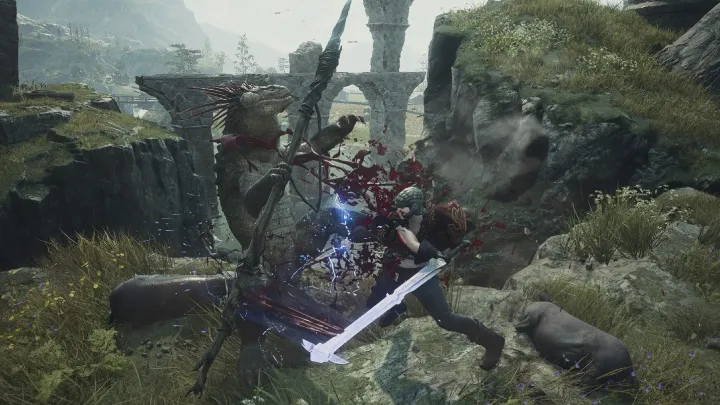Dragon’s Dogma 2 is an expansive open world action RPG filled with danger, strategy, and a deep companion system based on Pawns. For new players, the game can feel huge and complex, especially when you try to understand its combat, travel mechanics, exploration pacing, and vocation development. This guide will walk you through how to play Dragon’s Dogma 2 effectively, from the moment you start until you become a master Arisen capable of handling the most difficult challenges.
This how to article is structured in a time based, logical order, covering what you must learn first, what you develop next, and what you master later in the game. Each section contains multiple paragraphs explaining gameplay systems, practical strategies, and field tested tips. The goal is to help you understand not only what to do, but why each step matters. Whether you are a veteran of the original Dragon’s Dogma or a new adventurer stepping into this world for the first time, this complete guide will lead you through all the essentials.
How to Understand the Basics of Being the Arisen

Your journey begins when you awaken as the Arisen, the chosen individual whose heart is taken by a dragon. This marks the starting point of your adventure and introduces you to the core mechanics of movement, stamina, climbing, and dealing with early enemies. Learning these basics is crucial because Dragon’s Dogma 2 focuses heavily on positioning, awareness, and adaptability instead of fixed combat patterns.
The first thing every player must understand is stamina management. Actions such as sprinting, climbing, jumping, and heavy attacks consume stamina. Allowing your stamina to reach zero will leave you vulnerable in dangerous situations. Practicing how to retreat, reposition, and recover stamina during combat is essential for survival.
You should also familiarize yourself with how climbing works in this game. Many monsters such as Cyclopes and Griffins require you to climb their bodies to deal effective damage. Learning when to climb, when to let go, and how to strike their weak points will greatly improve your effectiveness in battle.
How to Choose the Best Vocation for Your Playstyle
Dragon’s Dogma 2 features a diverse vocation system that allows you to select from classic roles such as Fighter, Archer, Mage, and Thief. Each vocation has its own strengths, weaknesses, skills, and unique mechanics. Choosing the right vocation early helps you progress smoothly.
If you prefer close combat and tanking damage, the Fighter excels in blocking, drawing enemy attention, and delivering powerful melee strikes. For players who enjoy mobility and quick attacks, Thief offers dual blade combat, evasive techniques, and excellent stamina efficiency. The Archer is perfect for long range control and striking airborne enemies, while the Mage provides elemental magic, buffs, and healing.
As you advance, you can unlock hybrid vocations such as Warrior, Sorcerer, Trickster, and Mystic Spearhand. These advanced roles allow deeper customization and more powerful abilities. It is recommended to experiment with multiple vocations to discover which style suits your natural instincts.
How to Build and Develop Your Main Pawn
One of the most unique features of Dragon’s Dogma 2 is the Pawn system. Your Main Pawn is an AI companion you customize fully, from appearance to personality inclinations and vocation type. How you shape your Pawn will affect your effectiveness in battles and exploration.
A well balanced party usually includes a tank, a healer or support caster, and a damage dealer. If you choose a melee vocation yourself, consider giving your Pawn a support or ranged role to complement your strengths. If you play as a Mage, you may want your Pawn to serve as a front line Fighter who draws enemy attention.
Your Pawn learns through experience. When you explore ruins, fight specific monsters, or complete quests, your Pawn will gain knowledge that helps other players when they borrow your Pawn in their world. This system also lets your Pawn return with extra rewards when hired by other Arisen.
How to Form an Effective Party With Support Pawns
Besides your Main Pawn, you can recruit two additional Support Pawns created by other players. These Pawns do not level up in your world, so selecting the right ones matters greatly. Look for Pawns that complement your party composition and fill missing roles.
Support Pawns often come with specialized knowledge about monsters or quests. A Pawn who knows how to fight a Chimera more efficiently can guide you to weak points and effective strategies. A Pawn with healing skills may drastically reduce your item consumption and keep your party alive longer.
Regularly rotate your Pawns to gain access to new skills, new knowledge, and different strengths. Since Pawns do not cost anything except Rift Crystals, it is wise to test various combinations until you find an ideal setup.
How to Explore the World Safely and Efficiently
The world of Dragon’s Dogma 2 is vast, dangerous, and filled with dynamic encounters. Unlike many RPGs, nighttime is extremely hazardous, with stronger monsters and limited visibility. Traveling during night significantly increases your risk.
Always carry enough lantern oil, healing herbs, and stamina consumables. Exploration in this game requires preparation. You should also make frequent use of campsites to rest, heal, and save your progress. Setting up camp allows you to avoid dangerous night travel and maintain a steady pace of exploration.
Be observant of the environment. Many hidden treasures, shortcuts, and safe paths are not marked clearly on the map. Listening to your Pawns can also help, as they often warn you of traps or point out secret passages.
How to Master Combat Strategies for Every Enemy Type

Combat in Dragon’s Dogma 2 is dynamic, fast paced, and requires awareness. Different enemy types behave in unique ways, so adapting your strategy is essential.
For large enemies like Ogres or Griffins, climbing their bodies and targeting weak points deals significant damage. For smaller but dangerous enemies such as Goblin shamans or bandit archers, staying mobile and using ranged attacks or quick melee strikes is key.
Team coordination matters. Using your Pawn’s strengths to distract or disable enemies while you strike from a safer angle is an important combat technique. Pay attention to elemental weaknesses as well. Fire is effective against many early game foes, while lightning or ice can counter more advanced monsters.
How to Increase Your Power Through Skills and Gear
As you progress, you will unlock new skills and augments that enhance your combat abilities. Each vocation has a variety of skills you can swap to match your current needs. You should regularly visit guilds and trainers to update your skill loadout.
Gear upgrades are equally important. Better weapons and armor significantly improve your survivability. Many strong pieces of equipment can be found through exploration, quest rewards, or specialized vendors. Remember to repair your equipment and keep your load manageable to avoid stamina penalties.
Augments provide passive bonuses that remain active even when you switch vocations. Collecting useful augments early gives you a strong foundation for late game challenges.
How to Manage Quests and World Progression
Dragon’s Dogma 2 contains main quests, side quests, and dynamic events that occur based on time or location. Some quests can be failed if ignored for too long, while others appear only during certain times of day.
It is essential to plan your quest routes. Focus first on quests that involve dangerous areas or require nighttime exploration, then handle safer tasks during the day. Always read quest descriptions carefully, as the game does not always mark the exact path.
Your choices can affect NPC storylines. Helping villagers, rescuing travelers, or defeating certain monsters may change the world in subtle ways. This gives your journey a personal touch and adds replay value.
How to Prepare for Late Game and Endgame Challenges
As you near the end of Dragon’s Dogma 2, enemies become more powerful and unpredictable. Late game zones often require specialized strategies and strong equipment.
Make sure your vocation is upgraded with advanced skills, and your Pawn has enough experience to assist you effectively. Restock essential items such as healing potions, buff items, and status recovery herbs.
Late game monsters require patience, positioning, and understanding of elemental reactions. Do not rush fights. Use the environment to your advantage, set traps, and use Pawn coordination to create safe openings.
Conclusion
Dragon’s Dogma 2 is a world of freedom, adventure, and demanding battles. Learning how to adapt, prepare, and use the Pawn system will turn your journey from overwhelming to rewarding. With the strategies above, players can explore confidently, develop strong builds, and enjoy the rich and dynamic gameplay the title offers. As the Arisen, your path is shaped by your curiosity, your decisions, and your mastery of the world around you. The deeper you dive into its systems, the more the game opens up in thrilling and unexpected ways.
Summary
A complete how to guide for mastering Dragon’s Dogma 2 covering vocations, Pawns, combat, exploration, quests, and late game strategy in a clear structured format.

















